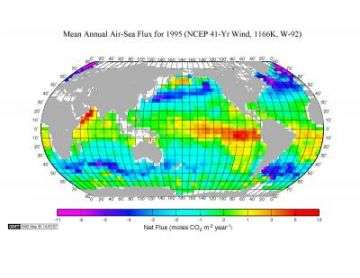Voyage to Southern Ocean aims to study air-sea fluxes of greenhouse gases

Scientists will embark this week from Punta Arenas, Chile, on the tip of South America, to spend 42 days amid the high winds and waves of the Southern Ocean. Here they hope to make groundbreaking measurements to explain how huge fluxes of climate-affecting gases move between atmosphere and sea, and vice-versa.
The cruise, which departs Feb. 28, should provide important information on how the greenhouse gas carbon dioxide moves between the ocean and atmosphere, said the cruise’s chief scientist, David Ho of Columbia University’s Lamont-Doherty Earth Observatory. Comprising 30 percent of global seas, “the Southern Ocean is a source of great uncertainty,” he said. “So it’s potentially important to our understanding of the global system.”
Humans put about 6 billion metric tons of CO2 into the air each year, mainly by fossil-fuel burning and deforestation. About a third is thought to be absorbed by oceans, and a third by plants or other components of land. The rest stays in the air—much of the reason why atmospheric CO2 is now building and climate is warming. However, there are huge uncertainties in the calculations—made so far mostly through indirect means--and fluxes seem highly variable from year to year, with some parts of the oceans habitually giving up CO2 while others absorb it. (The Southern Ocean usually absorbs it.) "Understanding how atmospheric carbon dioxide reacts with these cold surface waters is important for determining how the ocean uptake of carbon dioxide will respond to future climate change,” said Christopher Sabine, an oceanographer at the U.S. National Oceanic and Atmospheric Administration (NOAA). NOAA, NASA and the National Science Foundation are cosponsoring the cruise.
About 30 scientists from over a dozen institutions will traverse an area above Antarctica more than 1,000 miles east of Punta Arenas, aboard the 274-foot NOAA ship Ronald Brown. Here high, freezing winds unimpeded by landmasses roar much of the time, and waves can routinely top 30 feet. “The conditions are a little grim, but it’s ideal for study,” said Ho. He said that higher wind speeds correlate with faster exchange of gases, but there have been few studies aimed at directly measuring these exchanges under real-world conditions. The scientists say that wind speed itself probably does not drive gas exchange; the drivers are hard-to-observe phenomena driven by the wind, including turbulence and bubbles created by cresting waves. Another factor is the amount of phytoplankton taking CO2 from the water, which is usually measured by color. To figure out what is going on, the crew will dangle arrays of complicated instruments just above the water surface, and in the water column. “That will be a challenge, since the bow will be plunging off those big waves,” noted Sabine.
“NASA’s ongoing effort to understand the global carbon cycle will benefit from the data this cruise will produce,” said Paula Bontempi, manager of NASA’s ocean biology and biogeochemistry research program. "NASA's global satellite observations of ocean color will be improved, as we validate what our space-based sensors see with direct measurements taken at sea."
Source: Columbia University




















